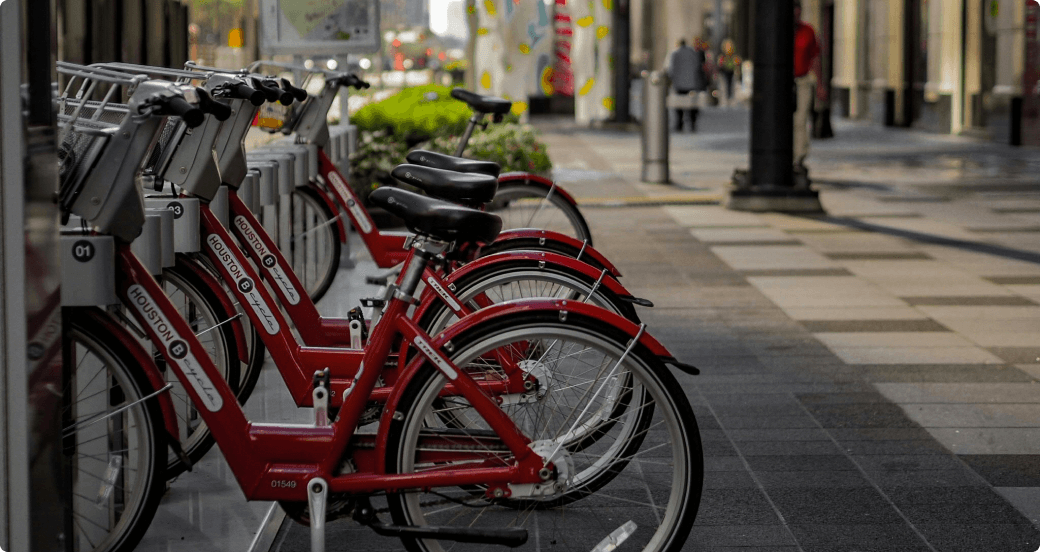При подборе транспорта для шеринга невозможно дать универсальный ответ, потому что на успех этого бизнеса влияет множество факторов: от истории до инфраструктуры города. Подробнее на эту тему рассказывали в прошлой статье.
В новом материале собрали сильные и слабые стороны великов, машин и самокатов, чтобы дать объективную картинку прокатного бизнеса.

Каршеринг — самый популярный тип проката!
Каршеринг с большим отрывом лидирует в отрасли транспортного шеринга. Он фактически превращается в новый вид общественного транспорта, помогает разгрузить дорожный трафик и улучшает экологию города. По этой причине власти активно поощряют развитие такого бизнеса и предоставляют льготы при оплате парковок.
Если обращаться к исследованиям, то эксперт по городскому планированию Дональд Шуп подсчитал, что 95 % времени личный автомобиль простаивает на парковке или на сервисном обслуживании, и только 5 % времени используется для поездок. А еще 1 шеринговое авто заменяет до 10 личных машин в день.
Портрет клиента
Классический пользователь каршеринга — житель центра и других густонаселенных районов города. Использование каршеринга для него — отличный способ добраться до работы или съездить по делам без необходимости оплачивать парковку.
Плюсы
- Активная государственная поддержка, чего нельзя сказать о других типах шеринга.
- Устойчивый рост спроса, ведь классическая аренда авто, такси и даже покупка своей машины уходят в прошлое, как экономически невыгодная модель поведения.
- Высокая рентабельность бизнеса в диапазоне от 15 до 30%, что несколько хуже, чем показатели других шерингов. Однако все еще сильно на фоне других венчурных отраслей, где отличным результатом считается 20%.
- Возможность расширения парка за счет аренды автомобиля физического лица на условиях раздела выручки
- Высокая виральность при продвижении сервиса, т.е. бизнес сам себя рекламирует за счет наклеек на авто.
- Отсутствие фактора сезонности, свойственного другому шеринговому транспорту
Минусы
- Главный минус каршеринга — капитал запуска составляет 500 тыс. дол. и выше.
- Сложность масштабирования бизнеса вне мегаполисов. Ведь спрос на каршеринг появляется там, где содержание и использование своего авто становится слишком дорогой. А такая тенденция характерна именно большим городам.
- Высокая стоимость эксплуатации автомобиля: топливо, страховка, ремонт, техобслуживание, оплата парковок и налоги.
- Частые повреждения авто вплоть до угона, что превращает транспортное средство в неликвидный товар и вынуждает тратить время на возмещение ущерба.
- Впрочем, эта проблема присуща любому виду шеринг транспорта, но в случае каршеринга суммы значительно больше.
- Безответственность и непорядочность водителей, из-за чего приходится перепарковать или даже эвакуировать авто. Также часто пропадает имущества из салона: подставки для телефона, щетки для чистки снега и т.д.

Кикшеринг — самый перспективный шеринг!
Кикшеринг — самая молодая и самая быстрорастущая отрасль транспортного шеринга в мире. Согласно прогнозам в ближайшие годы ожидается настоящий бум спроса на передвижения с помощью самокатов, что связано с изменением отношения пользователей к подобным сервисам.
Если раньше поездки воспринимались как развлечение, то теперь самокат становится реальной альтернативой для передвижения в больших городах, где много пробок и мало парковочных мест.
Портрет клиента
Самые активные потребители услуг кикшеринга — горожане 18–34 лет. Из них более 70% составляют мужчины. В качестве «рабочего инструмента» самокаты все чаще выбирают курьеры служб доставки еды и другие представители B2B-сегмента.
Плюсы
- Низкий порог входа на рынок — от 80 тыс. дол.
- Нет платы за использование инфраструктуры города.
- Очень высокая рентабельность в диапазоне от 30 до 50%.
- Возможность быстрого масштабирования в городах с населением от 200 тыс. чел.
- Возможность продавать в B2B-сегменте: крупные базы отдыха, сервисы доставки и т.д.
- Экологичность транспорта
Минусы
- Сезонность, хотя сейчас зимы часто теплые, а коммунальщики справляются.
- Зависимость от приспособленности городской инфраструктуры к микромобильности.
- Высокая вероятность травматизма среди клиентов.
- Необходимость постоянной подзарядки или смены аккумуляторов.
- Акты вандализма по отношению к транспорту
- Затраты на расстановку и релокацию самокатов из районов с низким уровнем спроса.
- Возможное сопротивление городских властей на фоне перенасыщенности рынка и создания дискомфорта для пешеходов и водителей.
- Высокая стоимость страховки транспорта

Байкшеринг — «китайское чудо»!
Волна популярности байкшеринга началась в 2014 году, когда в Китае обмен велосипедами стал настоящей сенсацией и получил миллиардные инвестиции. С тех пор индустрия распространилась по всему миру, однако бизнес прижился не везде.
Основные причины неудач разнятся в зависимости от региона. Так в Китае рынок был перенасыщен, что к привело к настоящим свалкам бесхозных велосипедов, а в Европе бизнес страдал от вандализма и воровства. Несмотря на проблемы, индустрия продолжает показывать устойчивую тенденцию к росту, а ведущие компании проделали хорошую работу над ошибками, выйдя на стабильную прибыль.
Портрет клиента
Здесь портрет клиента идентичен пользователям самокатов: горожане 18–34 лет, из них более 70% составляют мужчины, а также представители B2B-сегмента. Плюс к ним добавляются люди, которые следят за своим здоровьем.
Особенности бизнеса
В целом, преимущества и риски байкшеринга во многом дублируют кикшеринг, но есть и свои особенности:
Плюсы
- Низкий порог входа на рынок — от 80 тыс. дол.
- Нет платы за использование инфраструктуры города
- Высокая рентабельность в диапазоне от 30 до 50%.
- Возможность быстрого масштабирования в городах с населением от 200 тыс. чел.
- Возможность продавать в B2B-сегменте: крупные базы отдыха, сервисы доставки и т.д.
- Экологичность транспорта
- Более привычный вид транспорта для горожан
- Физическая нагрузка для любителей спорта
Минусы
- Сезонность в ряде регионов
- Зависимость от приспособленности городской инфраструктуры к микромобильности
- Высокая вероятность травматизма среди клиентов
- Необходимость постоянной подзарядки или смены аккумуляторов
- Акты вандализма по отношению к транспорту
- Затраты на расстановку и релокацию самокатов из районов с низким уровнем спроса
- Возможное сопротивление городских властей на фоне перенасыщенности рынка и создания дискомфорта для пешеходов и водителей
- Высокая стоимость страховки транспорта
- Велики менее популярны самокатов
- Во многих регионах рынок перенасыщен
- Более частые акты вандализма, в отличие от других типов транспорта
- Плохо подходит для офисных работников в качестве средства передвижения
Выводы
Итак, подведем итоги:
- Самый прибыльный прокат — это каршеринг, но чтобы войти в бизнес нужно быть миллионером или найти инвесторов.
- Наиболее перспективный тип проката — это шеринг самокатов. Кроме этого, входной порог не превышает 100 тыс. дол.
- Консервативный шеринг — это прокат байков. Популярность великов падает, но для многих они привычнее, что снижает «психологическое сопротивление новизне» со стороны клиента и властей.
Хотите запустить свой прокат? Пишите, звоните или оставляйте заявку, а мы поможем реализовать самые амбициозные идеи в вашем регионе!



